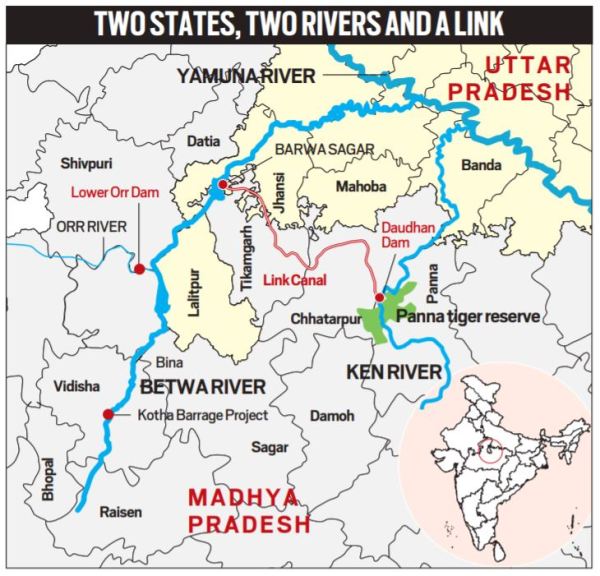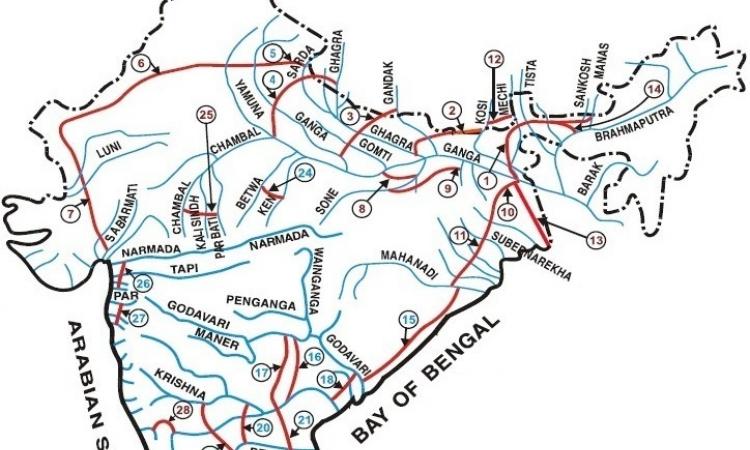ForumIAS announcing GS Foundation Program for UPSC CSE 2025-26 from 19 April. Click Here for more information.
Contents
- 1 Introduction
- 2 About Ken-Betwa river interlinking project
- 3 What is the National River Linking Project (NRLP)?
- 4 What is the rationale behind interlinking of rivers?
- 5 Are there previous examples of river-linking in India?
- 6 What are the advantages of Interlinking of Rivers?
- 7 What are the issues/challenges in Interlinking of Rivers?
- 8 What is the way forward?
| For 7PM Editorial Archives click HERE → |
Introduction
The funding and implementation of the Ken-Betwa river inter-linking project, a part of national river linking project (NRLP), has been approved by the Union Cabinet at a cost of ₹44,605 crore.
The Ken-Betwa project has the status of a national project, as the Centre will contribute 90% of the cost. It is also the first major centrally-driven river interlinking project in the country.
The project will pave the way for more interlinking of river projects in India.
With the process of creating the National Interlinking of Rivers Authority (NIRA) set in motion by the Centre, the topic of river interlinking merits a detailed discussion.
First, let us know more about the Ken-Betwa project.
About Ken-Betwa river interlinking project
The project involves transferring of water from the Ken river to the Betwa river through the construction of Daudhan dam and a 221-km canal linking the two rivers. Both these rivers are tributaries of river Yamuna.

A Special Purpose Vehicle (SPV) called Ken-Betwa Link Project Authority (KBLPA) will be set up to implement the project. The project has a deadline of eight years.
This project also comprehensively provides for environment management and safeguards. For this purpose, a comprehensive landscape management plan is under finalization by Wildlife Institute of India.
– For more on Ken-Betwa project: Read here
What is the National River Linking Project (NRLP)?
NRLP, formerly known as the National Perspective Plan, proposes to connect 14 Himalayan and 16 peninsular rivers with 30 canals and 3,000 reservoirs to form a gigantic South Asian Water Grid.
The initial plan to interlink India’s rivers came in 1858 from a British irrigation engineer, Sir Arthur Thomas Cotton.

NRLP includes two components:
– Himalayan component: This component aims to construct storage reservoirs on the Ganga and Brahmaputra rivers, as well as their tributaries in India and Nepal. It will connect, 1) the Ganga and Brahmaputra basins to the Mahanadi basin, and 2) the Eastern tributaries of the Ganga with the Sabarmati and Chambal river systems.
– Peninsular component: It includes 16 links that propose to connect the rivers of South India. It envisages linking, 1) the Mahanadi and Godavari to feed the Krishna, Pennar, Cauvery, and Vaigai rivers, 2) the Ken river to the Betwa, Parbati, Kalisindh, and Chambal rivers, 3) West-flowing rivers to the south of Tapi to the north of Bombay, and 4) Linking some west-flowing rivers to east-flowing rivers.
The NRLP is managed by National Water Development Agency (NWDA) under the Ministry of Jal Shakti. NWDA was set up in 1982, to conduct surveys and see how feasible proposals for interlinking river projects are.
Recently, it has been reported that the Centre is deliberating on creation of a National River Interlinking Authority (NIRA). It will have powers to set up SPV for individual link projects.
What is the rationale behind interlinking of rivers?
As per the govt, the project is needed to meet increasing water requirement in the country.
Core idea: Overall, the NRLP envisions the transfer of water from water ‘surplus’ basins (perennial Himalayan rivers) where there is flooding to water ‘deficit’ basins (rain-fed peninsular rivers) where there is drought/scarcity, through inter-basin water transfer projects.
Are there previous examples of river-linking in India?
In the past, several river linking projects have been taken up. For instance,
– Under the Periyar Project, transfer of water from Periyar basin to Vaigai basin was envisaged. It was commissioned in 1895.
– Similarly, other projects such as Parambikulam Aliyar, Kurnool Cudappah Canal, Telugu Ganga Project, and Ravi-Beas-Sutlej were undertaken.
– Godavari River has also been formally interlinked with the Krishna River at Ibrahimpatnam (near Vijayawada) in Andhra Pradesh in September 2015.
What are the advantages of Interlinking of Rivers?
i). Hydrological Imbalance of India: India has a large-scale hydrological imbalance with an effective rainfall period of 28 to 29 days. Some regions receive very high rainfall while some face droughts. Interlinking would transfer the water from flood-prone regions to draught-prone regions.
ii). Improve the inland navigation: Interlinking of rivers will create a network of navigation channels. Water transport is cheaper, less-polluting compare to the road and railways. Further, the interlinking of rivers can ease the pressure on railways and roads also.
iii). The benefit of irrigation: The interlinking of rivers has the potential to irrigate 35 million hectares of land in the water-scarce western peninsula. This will help India to create employment, boost crop outputs, farm incomes. Above all, the interlinking of rivers will make India a step closer to achieving food security.
iv). Generation of power: The interlinked rivers have the potential to generate a total power of 34 GW. This will help India to reduce coal-based power plant usage. Furthermore, It will also help to achieve India’s targets under Glasgow Climate Pact and under the Paris agreement.
v). Other benefits:
– Water supply: The project envisages a supply of clean drinking water amounting to 90 billion cubic meter. It can resolve the issue of drinking water scarcity in India.
– Similarly, interlinking of rivers has the potential to provide 64.8 billion cubic meter of water for industrial use.
– Apart from that, interlinking can help the survival of fisheries, protect wildlife in the summer months due to water scarcity. It can also reduce forest fires occurring in India due to climatic conditions.
– India can also explore an additional line of defence in the form of waterline defence.
What are the issues/challenges in Interlinking of Rivers?
The interlinking of rivers project has a variety of challenges. They are,
i). Impact of the Climate change: Reports points out that Climate change will cause a meltdown of 1/3rd of the Hindu Kush Region’s glaciers by 2100. So, the Himalayan rivers might not have ‘surplus water’ for a long time. Also, considering this, investing billions of money in the interlinking of rivers might yield benefits only for a short time.
ii). Human cost: This includes the challenge of loss of livelihood and displacement of people especially, the poor and tribal people located near the forests. So, the government not only needs to face challenges in displacing people but also in the rehabilitation of people.
iii). Huge financial cost: NRLP is a highly capital-intensive project. In 2001, the total cost for linking the Himalayan and peninsular rivers was estimated at Rs 5,60,000 crore, excluding the costs of relief and rehabilitation, and other expenses. This cost is likely to be substantially higher now, and the cost-benefit ratio might no longer be favourable.
iv). Impact on ecology and biodiversity: The ecology of every river being unique, letting the waters of rivers mix may affect biodiversity. Also, when most of the rivers in the country are polluted, this may cause mixing of a less polluted river with a more polluted one.
v). International Challenges: Countries like Bhutan, Nepal, and Bangladesh will be impacted due to the NRLP. Bangladesh esp fears of water diversion from the Ganga and Brahmaputra rivers to India’s southern states, threatening the livelihoods as well as its environment.
vi). Political Challenges: Water is a state subject in India. So the implementation of the NRLP primarily depends on Inter-State co-operation. Several states including Kerala, Andhra Pradesh, Assam, and Sikkim have already opposed the NRLP.
vii). Other Challenges: The government is proposing a canal irrigation method for transmitting water from one area to the other. The maintenance of canals is also a great challenge, it includes preventing sedimentation, clearing logging of waters etc.
Further, the government has to acquire large-scale lands for the smooth implementation of the project which is not easy.
What is the way forward?
– Efficient utilisation of existing resources: Integrated water resource management is the key for India. Moreover, curbing demand by efficient utilisation of existing water resources should be prioritised before making big-ticket investments in river interlinking under NRLP.
– Groundwater management is the key: The focus of India’s water resources should be about nurturing its Groundwater system. It would include identifying and protecting groundwater recharge mechanisms, enhancing recharge where feasible, installing artificial recharge and also regulating groundwater use at aquifer level.
– Virtual water: India should also push for the concept of virtual water. For example: Suppose when a country imports one tonne of wheat instead of producing it domestically, it is saving about 1,300 cubic meters of the local water. The local water can be saved and used for other purposes.
– National Waterways Project (NWP): As per some experts, the govt should consider the National Waterways Project (NWP) instead of the NRLP. Under NWP, water from a flooded river will flow to the other. It acts like a water grid, similar to a power grid. It just needs 1/3rd the land required for interlinking of rivers, is open to navigation throughout the year and involves zero pumping. Furthermore, it can irrigate almost double the land and has a 76% more power generation capacity (60 GW) compared to the interlinking of rivers project.




